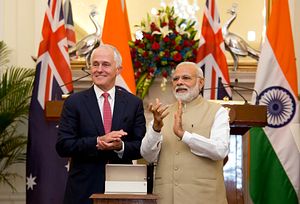A recent report commissioned by the Australian government seeks to plan for greater engagement with India in the coming decades. Authored by former Secretary of the Department of Foreign Affairs and Trade (DFAT) and High Commissioner to India Peter Varghese, the report contains 90 recommendations to transform Australia’s relationship with India. It sets the goal of lifting India into Australia’s top three export markets by 2035, as well as the third largest destination in Asia for Australian outward investment.
The report also specifies 10 Indian states that have compatible economic conditions for sectors where Australia should have a comparative advantage. These states generally have good records of economic management and governance, or have large populations, in the cases of Uttar Pradesh and West Bengal. The desire to identify these potentially compatible sectors and regions is driven by the need for Australia to strengthen its own economic resilience, and attempt to negate the country’s current economic dependence on China.
With increased economic convergence and growing people-to-people links, there is also an intention from Canberra to drive a greater strategic partnership between the two countries, with a hope that an emerging India will share Australia’s interests in the Indo-Pacific. However, this larger desire may not be a given, a number of tensions already exist between New Delhi’s approach within the international order and the existing norms that Australia is comfortable with. These tensions may also become more pronounced — or shift — as India’s state power grows, and if the Bharatiya Janata Party (BJP) remains in power.
While the development of this strategic relationship may or may not be compatible, one of the sectors that the report identifies where Australia can continue to enhance its relationship with India is education. The report identifies education as the “flagship sector,” owing to Australian expertise in the field, the great scale of India’s education requirements, and the fact that increased education and training is imperative to almost every aspect of the Indian economy. The sector also creates Australia-literate and sympathetic professionals returning to India, enhancing Australia’s networking capabilities and soft power influence.
Although India does contain some quality higher education institutions, improving the overall quality of education is paramount in order for India to take full advantage of its large and young population. The challenge of training this emerging group (estimated at about 400 million people) presents an opportunity for Australia both in terms of university collaboration, and as a destination for Indian students. Australia has become the second largest destination for Indian students (and now the second largest destination for all international students), and the education sector has become the main export of Australia to India.
The recent boom in education as an export has seen the sector become the state of Victoria’s primary economic generator, and the state’s own India Strategy, released in January, is similarly focused on the consolidation and expansion of education cooperation. Yet the facilitation of this growth may require some serious domestic planning. Australia’s universities are generally located in the country’s major urban centers. The student population of Victoria’s largest city, Melbourne, brings a great vibrancy to the city — alongside its economic and strategic factors — but successive infrastructure-shy state governments have hindered the urban connectivity required to both facilitate and enhance the phenomenon.
The ability to move student populations to and from the city’s widespread university campuses (three of which are isolated, with no rail connections) will be a vital domestic component of Australia’s ability to effectively utilize its education expertise for the Indian student market (or any other student market). Understanding domestic connectivity as a essential component of global connectivity seems to be something various Australian governments currently lack. Pursuing a greater role for a sector like education, which involves the movement of people to and around Australian cities, will require greater infrastructure commitments than are currently being considered.
While India’s size and its requirements as it further develops present a great opportunity for Australia, seeing India as simply the “next China” is a narrow vision of the country. It remains unlikely that India will follow China’s developmental path as a major manufacturing hub, or at least not to such a great extent. This needs to be recognized and understood by Australian governments and businesses wishing to engage with the country. A much greater literacy of the country needs to be fostered, and while the now 700,000 strong Indian diaspora in Australia is a great strategic asset for this goal, it cannot be the only answer.
Currently there are only two universities that teach Hindi in Australia: La Trobe University in Melbourne and the Australian National University in Canberra. This is down from six universities in 1997. Alongside this, only two primary schools in Victoria and six in New South Wales (NSW) offer classes in Hindi, and no secondary school in the country offers classes in the language at all. No other Indian languages are taught in public institutions in Australia, although the NSW government is currently exploring the idea of a Punjabi curriculum. If Australia is serious about enhanced engagement with India, then the education push should go both ways.

































